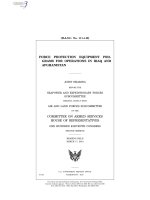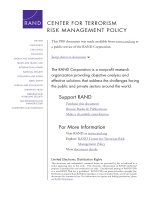Disjointed War - Military Operations in Kosovo, 1999 potx
Bạn đang xem bản rút gọn của tài liệu. Xem và tải ngay bản đầy đủ của tài liệu tại đây (1.8 MB, 171 trang )
Disjointed
War
Military Operations in Kosovo, 1999
Bruce R. Nardulli, Walter L. Perry, Bruce Pirnie
John Gordon IV, John G. McGinn
Prepared for the
United States Army
Approved for public release;
distribution unlimited
R
Arroyo Center
The research described in this report was sponsored by the United
States Army under contract number DASW01-01-C-0003.
RAND is a nonprofit institution that helps improve policy and
decisionmaking through research and analysis. RAND
®
is a
registered trademark. RAND’s publications do not necessarily reflect
the opinions or policies of its research sponsors.
© Copyright 2002 RAND
All rights reserved. No part of this book may be reproduced in any
form by any electronic or mechanical means (including
photocopying, recording, or information storage and retrieval)
without permission in writing from RAND.
Published 2002 by RAND
1700 Main Street, P.O. Box 2138, Santa Monica, CA 90407-2138
1200 South Hayes Street, Arlington, VA 22202-5050
201 North Craig Street, Suite 102, Pittsburgh, PA 15213
RAND URL: />To order RAND documents or to obtain additional information,
contact Distribution Services: Telephone: (310) 451-7002;
Fax: (310) 451-6915; Email:
Library of Congress Cataloging-in-Publication Data
Disjointed war : military operations in Kosovo, 1999 / Bruce R. Nardulli [et al.].
p. cm.
“MR-1406.”
Includes bibliographical references.
ISBN 0-8330-3096-5
1. Kosovo (Serbia)—History—Civil War, 1998—Campaigns. 2. North Atlantic
Treaty Organization—Armed Forces—Yugoslavia. I. Nardulli, Bruce R.
DR2087.5 .D57 2002
949.703—dc21
2002024817
Cover design by Stephen Bloodsworth
Cover photos courtesy of U.S. Air Force Link (B2) at www.af.mil,
and NATO Media Library (Round table Meeting) at www.nato.int.
iii
PREFACE
Following the 1999 Kosovo conflict, the Army asked RAND Arroyo
Center to prepare an authoritative and detailed account of military
operations with a focus on ground operations, especially Task Force
Hawk. In response, the Arroyo Center delivered a classified report
for use by the Army Staff and others with an interest in the Kosovo
conflict. This document is an unclassified version of that report. The
purpose is to offer the Army a more accessible document, while also
reaching a wider audience. It should interest those concerned with
employment of Army and joint forces. It should also interest those
concerned with broader national security issues, especially the
planning and conduct of contingency operations.
This research was sponsored jointly by the Director of Strategy,
Plans, and Policy, Office of the Deputy Chief of Staff for Operations
and Plans (G-3); the Director of the Center for Land Warfare (with
sponsorship now assumed by the Director, Army Quadrennial
Defense Review Office); Office of the Deputy Chief of Staff for
Programs; and the Technical Advisor to the Deputy Chief of Staff for
Operations and Plans. It was conducted in the Arroyo Center’s
Strategy, Doctrine, and Resources Program. The Arroyo Center is a
federally funded research and development center sponsored by the
United States Army.
iv Disjointed War: Military Operations in Kosovo, 1999
For more information on RAND Arroyo Center, contact the Director
of Operations (telephone 310-393-0411, extension 6500; FAX 310-
451-6952; e-mail ), or visit the Arroyo Center’s Web
site at />v
CONTENTS
Preface iii
Figures ix
Tables xi
Summary xiii
Acknowledgments xix
Abbreviations xxi
Chapter One
INTRODUCTION 1
A Battle of Constraints and NATO’s Strategic Choices 2
Impact on Planning 3
Impact on Air Operations 4
Impact on Task Force Hawk 5
The Deficiencies of Operation Allied Force 6
About the Report 8
Chapter Two
AT THE BRINK: APRIL 1998 TO MARCH 1999 11
Mounting Tensions and Concerns Over Kosovo 13
Initial NATO Planning 13
October Crisis 15
Rambouillet and Its Aftermath 17
Chapter Three
AIR OPERATION 21
NATO and U.S. Goals 21
vi Disjointed War: Military Operations in Kosovo, 1999
Public Renunciation of Ground Force Options 22
Initial Operations 24
Command and Control 25
Restrictions on Air Operations 27
Yugoslav Forces 27
Air Defense 28
Ground Forces in Kosovo 30
Slowly Expanding Air Operations 31
Introduction of Naval Air 31
Expansion of Fixed Targets 32
Aircraft Reinforcement 32
Controversy Over the Weight of Effort 33
NATO’s Determination to Prevail 36
Turning Point: The NATO Summit Conference 36
Escalating Attacks on Yugoslav Infrastructure 37
Halting Steps Toward a Possible Land Invasion 38
Tightening the Noose: The Ahtisaari-Chernomyrdin
Mission 43
Successes and Limitations of the Overall Air Operation 44
Overall Success 45
Fixed Targets 45
Limited Collateral Damage 46
Operational Problems 47
Low Effectiveness of Air Strikes Against Fielded Forces 48
Marginal Effect in Halting Violence Against Kosovar
Albanians 49
Joint Chiefs of Staff Briefing, June 10, 1999 50
NATO SHAPE Briefing, September 16, 1999 52
The Allied Force Munitions Effectiveness Assessment
Team 53
Annual Data Exchange, Sub-Regional Arms Control 54
Summary of Strike Assessments 54
Chapter Four
TASK FORCE HAWK 57
Origin and Controversy 57
The Decision to Deploy Task Force Hawk 59
The Change to Albania 61
Deployment of Task Force Hawk 66
Command and Control 76
Contents vii
Command and Control at Rinas 78
Task Force Hawk Operations 80
Deep Operations Planning 80
Mission Planning 82
Training and Rehearsals 85
Forward Operating Base 87
Integration with Air Operations and Targeting 88
Task Force Hunter 92
Why Wasn’t Task Force Hawk Employed in Kosovo? 94
Contributions of Task Force Hawk 95
Operational and Tactical Contributions 96
Chapter Five
ENFORCING THE PEACE 99
Preparation for Operation Joint Guardian 99
United Nations Security Council Resolution 1244 100
Initial Operations in Kosovo 101
Kosovo Force Structure and Disposition 101
Entry of Task Force Falcon 103
Initial Tasks 104
Challenges Facing KFOR 105
The Law and Order Problem 106
U.S. Emphasis on Force Protection in Kosovo 108
Kosovo in Contrast to Bosnia 109
Chapter Six
CONCLUSION 111
The Leverage Derived from an Air-Land Campaign
Approach 111
Joint “Air-Only” Operations 112
Designation of a Land Component Commander 113
Sensor-to-Shooter Response Time 115
Joint Doctrine for Attack Helicopter Operations 115
Planning for Major Political Constraints on Future
Military Operations 116
Characteristic Restraints 116
Tendency to Rely on Air Power 117
Improving Military Planning 118
The Army’s Title 10 Planning Responsibilities 118
Need for Expanded Ground-Force Options 119
Disparities in Coalition Capabilities 120
viii Disjointed War: Military Operations in Kosovo, 1999
Need for Increased Army Capability to Conduct Civil
Police Tasks 120
Final Thoughts 121
Appendix: LIST OF INDIVIDUALS CONSULTED 123
Bibliography 127
ix
FIGURES
2.1. Map of the Balkan Region 12
3.1. Command Headquarters Locations 26
3.2. Basic Process for Attacking Fielded Forces 35
3.3. Refugee Flow, March 23 to June 8, 1999 50
4.1. Initial Task Force Hawk Structure (Macedonia) 62
4.2. Rinas Airport at Tiranë 65
4.3. Battling MOG and Mud: The Two C-17 Maximum at
Rinas 69
4.4. Ground Conditions at Rinas, Early May 70
4.5. Task Force Hawk Helicopter Self-Deployment 72
4.6. Army Apaches and Blackhawks Arriving at Rinas 73
4.7. Task Force Hawk Structure 74
4.8. Task Force Hawk Command Relationships 77
4.9. Task Force Hawk Deep-Attack Concept 84
4.10. Apaches Lifting Off for Mission Rehearsal Exercise 87
4.11. Joint Targeting Process 91
4.12. Army Hunter UAV 92
5.1. KFOR Multinational Brigades 102
xi
TABLES
3.1. Attacks on Fielded Forces 51
3.2. Yugoslav Annual Data Exchanges 55
xiii
SUMMARY
All military operations have problems, and NATO’s Operation Allied
Force was no exception. Nor did it accomplish every objective. But
whatever problems plagued the operation, the outcome was a clear
victory for NATO. Operation Allied Force compelled the Yugoslavs to
end the ethnic cleansing and expulsion of Kosovar Albanians, with-
draw their forces from Kosovo, accept an international military pres-
ence in the province, and permit the unconditional return of
refugees. Arguably, it also compromised Slobodan Milosevic’s ability
to hold on to power and ultimately resulted in his incarceration.
All of that said, problems abounded during the NATO military
operation, and this report focuses on these problems because they
offer a rich trove of lessons for future operations. Specifically, we
focus on a subset of problems, those implicit in our title “Disjointed
War.” Allied Force was a joint (multiservice) operation, but it was not
fought that way—at least to the extent that it could and should have
been. This was especially true when it came to joint planning and
operations in integrating air and ground capabilities. Operation
Allied Force was also a combined, multinational operation. Fighting
as an alliance brought essential political benefits, but it also induced
a host of issues that had important operational military implications.
These joint and combined difficulties caused confusion, probably
made the operation less effective than it could have been, and pos-
sibly delayed victory. Had Milosevic not capitulated and had the
allies eventually decided to launch a ground offensive, this
“disjointedness” could have had severe consequences.
xiv Disjointed War: Military Operations in Kosovo, 1999
A primary influence shaping the operation was the fact that at the
outset none of the NATO countries had overriding national interests
in the Kosovo crisis. True, conflict in the Balkans could spin out of
control and create important problems for European nations, but
national survival was not at stake. This absence of a vital interest
shaped the allied response in fundamental ways. It fostered a cau-
tious and incremental approach intended to minimize casualties and
avoid any event that might make it difficult to walk away from the
conflict if necessary. Substantial friendly casualties might have made
it very difficult to withdraw, and this desire underpinned the decision
to use only aircraft within restrictive operational guidelines.
THE JOINT APPROACH
Joint operations derive much of their effectiveness from the fact that
they foreclose an opponent’s options. Dispersing forces to keep
them from becoming a lucrative target for air strikes typically leaves
an opponent more vulnerable to piecemeal defeat on the ground.
Concentrating combat units to increase their effectiveness in ground
operations can increase their vulnerability to air attack. NATO’s
early decision for an air-only operation, which mirrored U.S. state-
ments and sentiment, essentially ceded the initiative to Milosevic,
enabling him to undertake his program of ethnic cleansing. His tac-
tics of dispersion, coupled with concealment and sporadic use of his
air defenses, effectively trumped the only card NATO was willing to
play.
None of this is to minimize the host of problems that would have
clustered around any decision to send ground forces into Kosovo or
the advantages that the air-only approach offered. Indeed, the deci-
sion represented a pragmatic recognition that NATO had not mus-
tered the political will to commit its ground forces and that, if any-
thing were to be done, it had to be an air operation. Nonetheless, a
sober explanation of the limitations of a one-dimensional operation
might have clarified the consequences of committing to such an
operation and might have dispelled the notion that the threat of
bombing or a few days of actual air strikes would cause Milosevic to
back down.
The one-dimensional approach hampered the operation in other
ways. For example, U.S. military doctrine outlines the command
Summary xv
structure of joint task forces, including the designation of compo-
nent commanders for land, maritime, and air forces. However, a
land component commander was never designated for U.S. Joint
Task Force Noble Anvil, the force that became the parent unit of the
Army’s Task Force Hawk. This absence complicated planning and
day-to-day coordination. Furthermore, it took until late in the oper-
ation to achieve well-integrated joint targeting. Air Force targeters
do not (and should not) have the expertise to plan attacks against
ground forces. The Army and Marine Corps have this expertise, but
in the absence of a joint targeting structure it was difficult to apply.
Eventually the problem was solved, but not until late in the conflict.
One consequence of not having a true joint operation remains
speculative: poorly developed ground operations. Because ground
forces were rejected early in the decision process, no serious, com-
prehensive planning for their use took place. Some national staffs
undertook a series of informal “assessments,” but they lacked the
comprehensiveness and coordination that effective plans require.
Had Milosevic decided to weather the storm of air attacks longer
than he did, the absence of joint planning almost certainly would
have delayed an allied ground attack operation, pushing it into the
winter or delaying it until the following spring, both bad options for
the allies.
The operation also uncovered a gap in joint procedures: use of
attack helicopters without ground forces. U.S. doctrine provides for
attack helicopters to carry out deep strikes, but typically these occur
as a combined arms team that includes ground maneuver forces.
When Task Force Hawk deployed, established procedures did not ex-
ist for employing attack helicopters for deep strike in conjunction
with air operations and without ground forces. Procedures were de-
veloped over time, but because the helicopters were never employed,
the procedures were never tested. Joint doctrine was also not fol-
lowed, in that supported and supporting command relationships
were not established. In light of these experiences, then existing
joint doctrine and tactics, techniques, and procedures (TTPs) were
not well developed for the circumstances encountered. Therefore,
there is a need for the Army and Air Force to develop more robust
procedures for using attack helicopters in an air-only operation.
xvi Disjointed War: Military Operations in Kosovo, 1999
OTHER COORDINATION ISSUES
The lack of proficiency at employing joint procedures created one set
of problems; additional discontinuities created others. One was a
fundamental disagreement between the commander in chief (CINC)
and his Air Component Commander about how to prosecute the air
war. The former saw Yugoslav ground forces as a key center of grav-
ity and the ultimate guarantor of Milosevic’s power, and he wanted
to attack them. The latter, recognizing the difficulty of doing serious
damage to ground forces, judged attack of fixed targets as the best
way to pressure Milosevic. Eventually, General Wesley Clark, NATO’s
Supreme Allied Commander Europe (SACEUR) as well as the U.S.
European Command (USEUCOM) Commander, ordered Lieutenant
General Michael Short, Commander, Allied Air Forces Southern
Europe, to direct more attacks against ground force targets, but the
differing philosophies remained a source of tension throughout the
operation.
Task Force Hawk was also a contentious issue, but here the tension
was between the CINC and the services, primarily the Army. Under
U.S. procedures, the military services provide the forces the regional
CINC determines he needs to carry out the mission given him by the
National Command Authority. Thus, when General Clark requested
an attack helicopter force, he expected the Army to provide it. But
the Army leadership was skeptical of using helicopters in this specific
situation, and all four services disagreed with the request when it was
staffed through the Joint Staff. Eventually, the National Command
Authority acceded to the CINC’s request and authorized the deploy-
ment—but not the employment—of Task Force Hawk.
These sorts of discontinuities in military operations are not rare;
indeed, they occur routinely. That an Army officer had a different
view from an Air Force officer on the best way to prosecute an air
operation or that a CINC disagreed with the Joint Staff about what he
needed will surprise no one. What makes these differences note-
worthy is their relevance to future operations. The United States can
expect to find itself involved in future operations that will raise the
same sorts of issues. Addressing them now will not only speed
coordination in the future, but should also result in more effective
operations.
Summary xvii
RECOMMENDATIONS
The report makes a number of recommendations in the final chap-
ter. Key among them are the following:
• A land component commander (LCC) should be routinely desig-
nated in joint operations against enemy land forces, whether or
not sizable U.S. land forces are expected to be deployed in com-
bat. The LCC is an essential advisor to the Joint Force Comman-
der and can facilitate access to Army and Marine Corps targeting
and planning assets and competence.
• In the case of striking fielded forces, the link between the sensors
detecting the targets, the controllers authorizing strikes against
those targets, and the shooters firing on the targets has too many
parts and takes too long to be effective against such fleeting tar-
gets. A joint counterland control center should be established to
speed this process and provide dynamic control of sensors and
shooters.
• A contingency analysis cell should be established in the Army to
aid the Army Chief of Staff, as a member of the Joint Chief of
Staff, and CINCs in identifying and assessing land force options
during crises and conflicts. This is particularly important in
unanticipated situations where current plans do not exist or are
inadequate.
• The Army needs to develop more expeditionary options below
the corps level. Task Force Hawk exemplifies the kind of modu-
larity the Army may need to offer to be most relevant in future
operations. Smaller, more responsive, and more flexible force
options must be part of the Army’s overall inventory.
xix
ACKNOWLEDGMENTS
Many people contributed to this report. Without their willing coop-
eration, the work could not have been completed. Research on
operations reflected in this report was conducted by our colleagues
John Bondanella, Richard Brennan, John Halliday, Richard Kedzior,
and Deborah Peetz. For their continuous support, we thank our
Army co-sponsors: Mr. Vernon Bettencourt, Technical Advisor to the
DCSOPS, MG Robert St. Onge, Jr., and MG John R. Wood, Director,
Strategy, Plans, and Policy (DCSOPS); Dr. Robin Buckelew, Director,
Center for Land Warfare; and BG Lynn Hartsell, Director, Army QDR
Office (DCSPRO). We also thank our points of contact with the spon-
sors for their support and access throughout this effort: Ms. Gail
Lankford (Office of the Technical Advisor), LTC Robert Everson
(Strategy, Plans, and Policy), and Mr. Timothy Muchmore (Center for
Land Warfare/Army QDR Office). Jacqueline Henningsen, Director
of Air Force Models and Simulation, assisted in securing Mission
Analysis Tracking and Tabulation data from the Air Force’s Warrior
Preparation Center in Germany. We also gratefully acknowledge the
support, guidance, and substantive contributions of David Kassing,
director of the Strategy, Doctrine, and Resources Program in the
Arroyo Center. RAND colleagues Lynn Davis, Paul Davis, Tom
McNaugher, and Alan Vick all provided thoughtful and incisive
reviews during the course of this research, as did Richard H.
Sinnreich. Jerry Sollinger’s organizational and editorial skills sub-
stantially improved and sharpened the final report. Special thanks to
Regina Wright for her care and patience in the preparation of this
document and to Joanna Alberdeston and Karen Echeverri for
adding the finishing touches. We would also like to recognize the
contributions of our RAND colleagues Kathy Mills, Jennifer Casey,
xx Disjointed War: Military Operations in Kosovo, 1999
Gail Kouril, and MAJ Steve Perry, an Army Fellow. Also of RAND,
Laurent Murawiec provided insightful comments on aspects of the
NATO operations.
Finally, the report could not be realized without the invaluable assis-
tance of many individuals involved in Operation Allied Force who
provided information and in many cases interviews. These individ-
uals are listed in the appendix.
xxi
ABBREVIATIONS
ABCCC Airborne Battlefield Command and Control
Center
ACC Air Component Commander
AFAC Airborne Forward Air Controller
AFOR Albanian Forces
AFSOUTH Allied Forces Southern Europe
APC Army Personnel Carrier
ARRC Allied Command Europe Rapid Reaction Corps
ATACMS Army Tactical Missile System
BCE Battlefield Coordination Element
CAOC Combined Air Operations Center
CBU Cluster Bomb Unit
CRG Contingency Response Group
CINC Commander in Chief
DOCC Deep Operations Coordination Cell
FLIR Forward-Looking Infrared Radar
JSOTF Joint Special Operations Task Force
JTF Joint Task Force
KFOR Kosovo Force
xxii Disjointed War: Military Operations in Kosovo, 1999
KLA Kosovo Liberation Army
MEU Marine Expeditionary Unit
MLRS Multiple Launch Rocket System
MNB Multi-National Brigade
MOG Maximum on Ground
MUP Ministarstvo Unutrasnjih Poslova (Ministry of the
Interior)
NATO North Atlantic Treaty Organization
NCA National Command Authority
OSCE Organization for Security and Cooperation in
Europe
ROE Rules of Engagement
SACEUR Supreme Allied Commander Europe
SHAPE Supreme Headquarters Allied Powers Europe
SOCEUR Special Operations Command Europe
TF Task Force
TLAM Tomahawk Land Attack Missile
U.K. United Kingdom
U.S. United States
UAE United Arab Emirates
UAV Unmanned aerial vehicle
UN United Nations
UNHCR United Nations High Commissioner for Refugees
UNMIK United Nations Interim Administration in Kosovo
UNSCR UN Security Council Resolution
USA U.S. Army
USAREUR U.S. Army Europe
Abbreviations xxiii
USAF U.S. Air Force
USAFE U.S. Air Forces in Europe
USEUCOM U.S. European Command
USN U.S. Navy
USNAVEUR U.S. Navy, Europe
VJ Vojska Jugoslavije (Yugoslav Army)
1
Chapter One
INTRODUCTION
The Kosovo conflict was unique in the history of the North Atlantic
Treaty Organization (NATO). For the first time, the alliance con-
ducted an offensive military operation to compel another country to
accept its terms. For 78 days NATO waged a conflict under extremely
demanding political and military conditions, ultimately forcing Yu-
goslavia to end Serb violence against the Kosovars, withdraw all
Yugoslav forces from Kosovo, accept an international military pres-
ence in the province, and allow the unconditional return of all
refugees. With the end of hostilities, NATO moved the Kosovo Force
(KFOR) into Kosovo to establish basic law and order and provide
protection for the people of Kosovo, a key NATO objective. In forcing
Belgrade to accept its terms, NATO also demonstrated the alliance’s
resolve and ability to hold together in the face of many divisive pres-
sures. The alliance accomplished all of this without committing
ground forces to combat and without suffering any combat fatalities.
By these many measures, Operation Allied Force can indeed be
deemed a major success.
Yet NATO’s use of force in dealing with Belgrade also revealed seri-
ous problems. What was to be a quick military operation instead
became a 78-day campaign during which hundreds of thousands of
Kosovars were displaced and thousands killed. One of the primary
reasons for initiating military operations—to stop and deter further
ethnic cleansing—was achieved in the end but at great cost to the
Albanian Kosovars. NATO also set itself an objective to reduce the
capability of Serb military forces to wage violence in the future. This
too turned out to be a largely unmet goal, as Serb fielded forces sur-
vived NATO’s air war largely intact. Finally, on the eve of Slobodan









